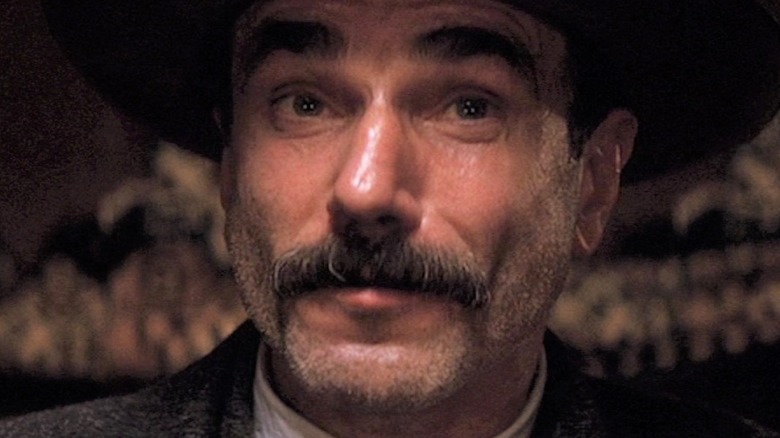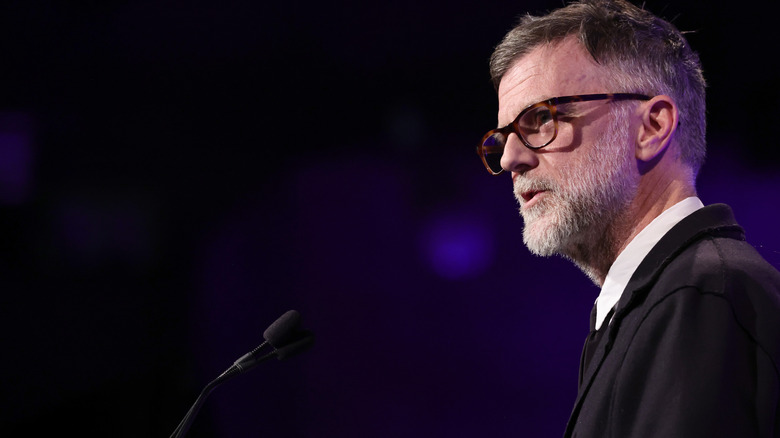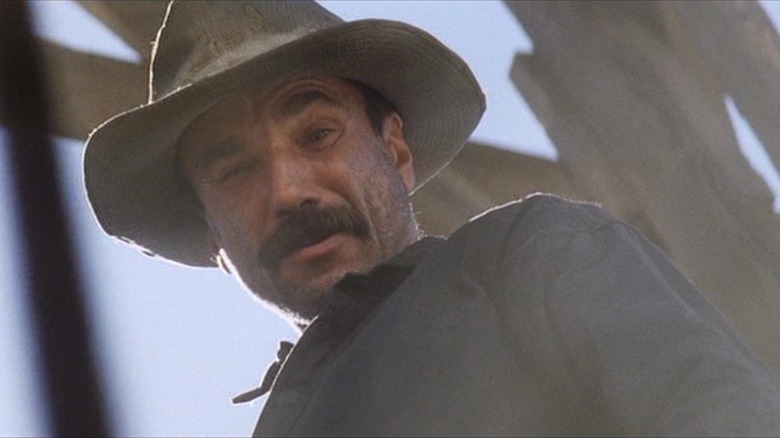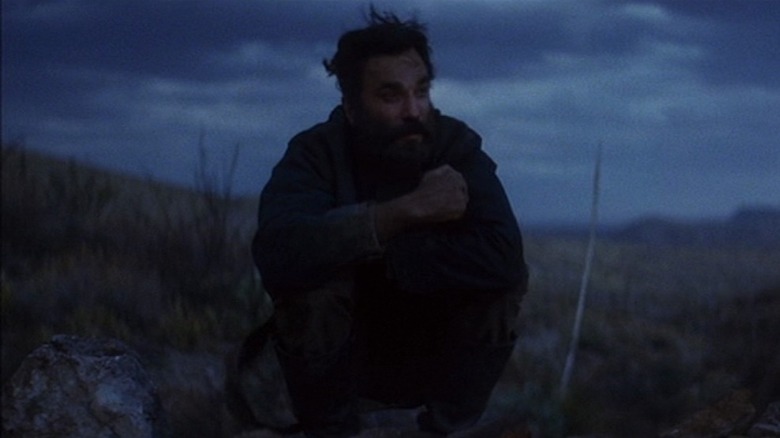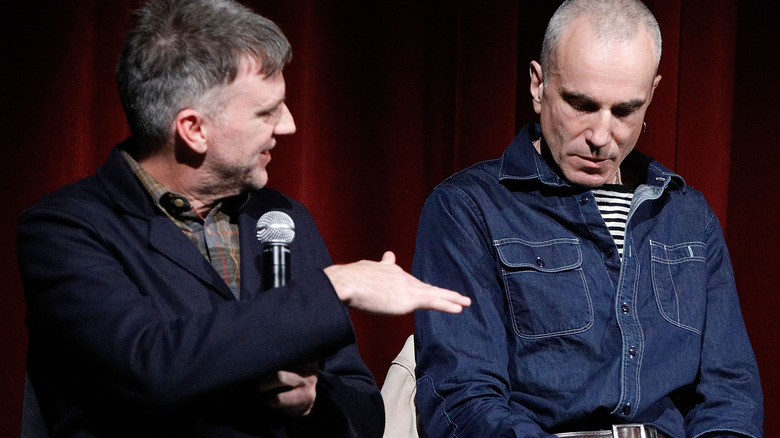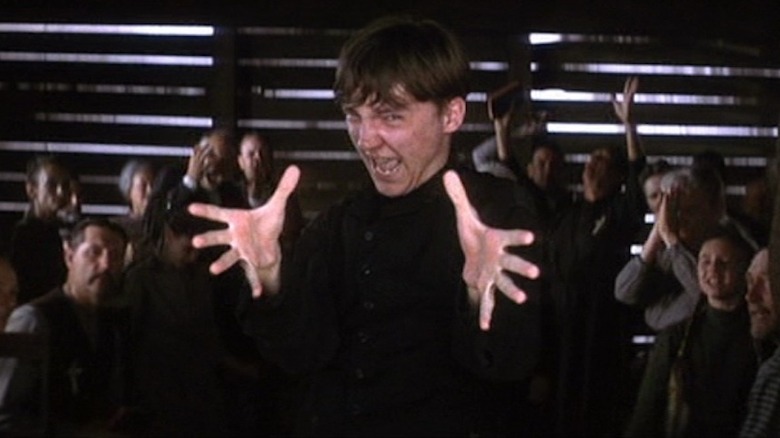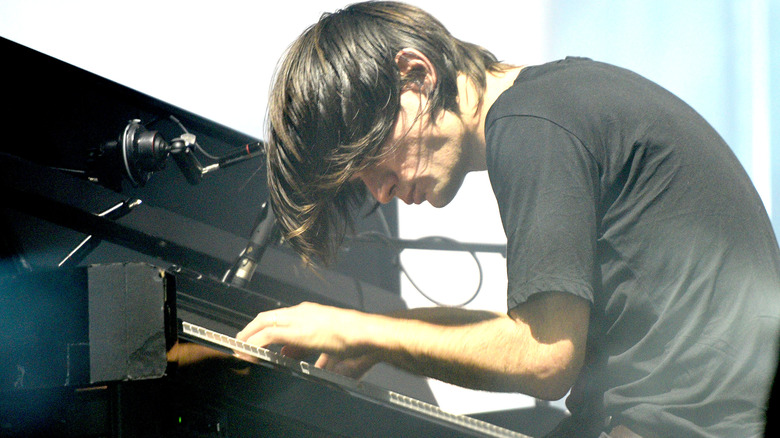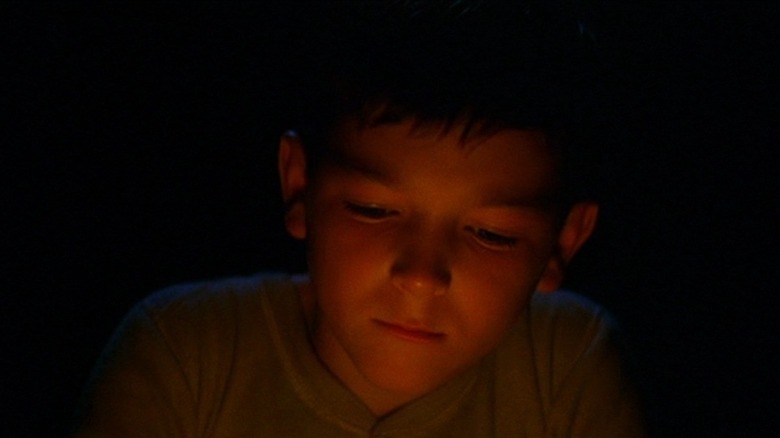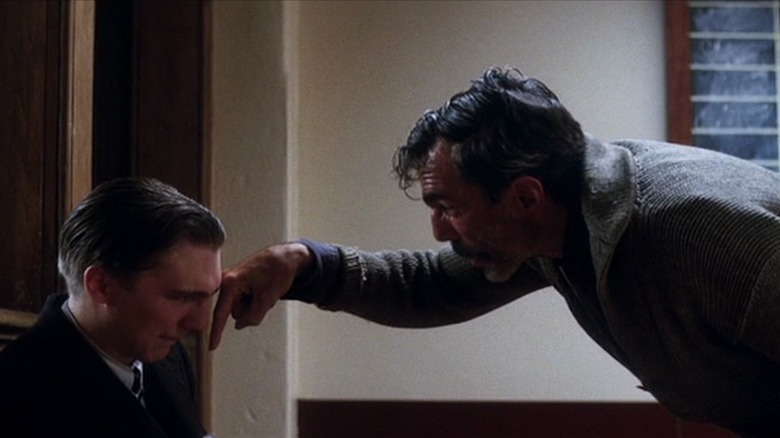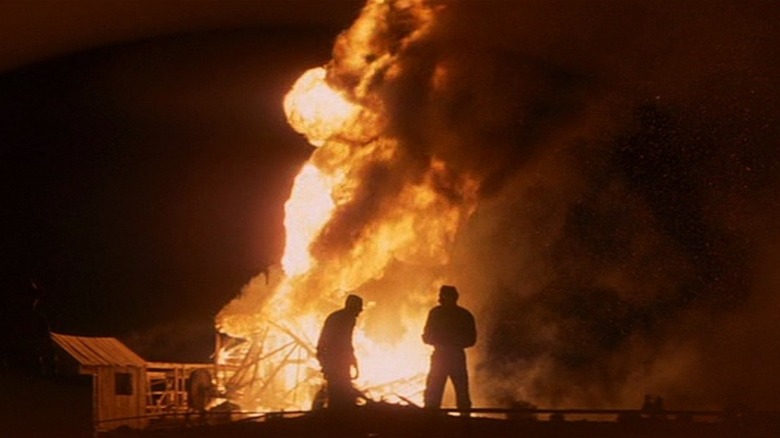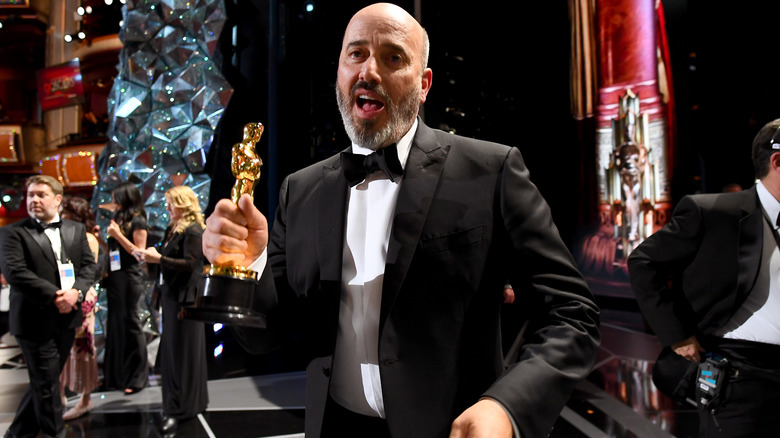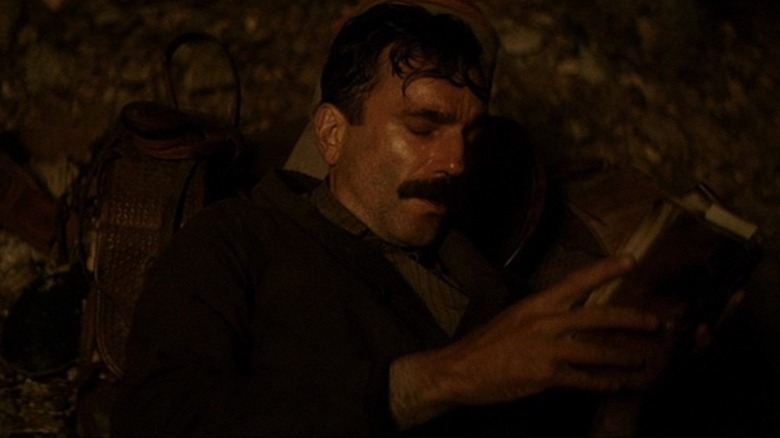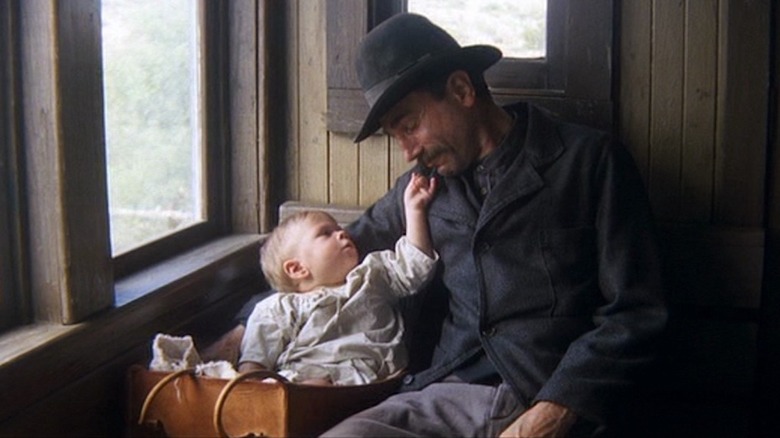The Untold Truth Of There Will Be Blood
When "There Will Be Blood" premiered in 2007, it felt like an event. Critics and audiences responded to the film's sheer otherworldly force, with Peter Travers of Rolling Stone writing, "Seeing 'There Will Be Blood' is like going ten rounds with a raging bull. You feel so pummeled it's hard to get your head clear." While the film took home only two Oscars — one for lead Daniel Day-Lewis and one for cinematographer Robert Elswit — its broad swath of nominations for everything from best picture to sound editing shows its overall excellence. Everything here is firing on all cylinders.
This is a movie that leaves behind a permanent mark on its viewers, whether they're stunned by the nearly bestial fervor of Daniel Day-Lewis' performance, haunted by its unsettling ending, or struck by its lonely and often desolate landscapes. We're fascinated by that impact — and by everything that led to it. "There Will Be Blood" has a complex and multifaceted origin story, one that feels like it combines the best elements of chance, fate, work, and genius. Let's try to unravel all the elements that went into making a contemporary masterpiece.
How Paul Thomas Anderson struck inspirational oil
Amazingly, we owe "There Will Be Blood" — a thoroughly American blend of the Western and a "Citizen Kane"-style rise and fall — to London. Paul Thomas Anderson was there, homesick and at loose ends creatively, when he chanced upon a copy of Upton Sinclair's novel "Oil!" As The Guardian puts it, "It rang instant bells with him; not only as a piece of his own local history but as a perfect backdrop to his [stalled] story about fighting families." Best of all, as Anderson told The New York Times, "It had a painting of California on the cover," which was the perfect appeal to his longing for home.
"Oil!" fans won't recognize too much of the novel in "There Will Be Blood," which is more of a riff on Sinclair's work than a strict adaptation. The New York Times charts some of the differences and similarities between the two. To oversimplify it, "Oil!" is more explicitly and fiercely political, and it doesn't center as thoroughly on its antihero. It's a source of inspiration for Anderson — illuminating the structure and milieu he needed for a preexisting idea — rather than a road map. Still, it's indispensable; that eureka moment for the director was pivotal in getting us this version of Anderson's "fighting families" story. The New York Times notes that the novel even supplies one of the movie's best and most visually stunning scenes — "the fiery immolation of an oil rig."
The real Daniel Plainview?
While Paul Thomas Anderson's screenplay took its official inspiration from Upton Sinclair's "Oil!", Anderson explained to The A.V. Club that it's a very loose adaptation that confines itself to only the first few hundred pages. As he put it, "That's not to say I didn't really like the book; I loved it. But there were so many other things floating around. And at a certain point, I became aware of the stuff [Sinclair] was basing it on. What he was writing about was the life of [oil barons] Edward Doheny and Harry Sinclair." So Anderson started drawing from history as well as from fiction, adapting America itself more than any particular novel.
Doheny, as he mentioned, was a particular inspiration — both for him and for Upton Sinclair. The New York Times explains Doheny's history, including his rise from wandering, hardscrabble prospector to wealthy oil tycoon. (The Doheny family was even eventually touched by some "There Will Be Blood"-style violent tragedy, when Ned Doheny Jr. was murdered in his own home.) Doheny's mark on "There Will Be Blood" goes beyond inspiration, however. His mansion actually appears in the film as Daniel Plainview's own home, including the infamous bowling alley.
According to Anderson's interview with The A.V. Club, the Doheny mansion lent the production exactly the right tone. "It's definitely pretty ghostly around there, without question. Daniel [Day-Lewis] called it a pyramid that Doheny built to himself." That haunted, prideful grandeur made it a perfect match for Daniel Plainview.
Drawing from cinematic history
If you want to draw a cinematic family tree for "There Will Be Blood," you have to include its most significant ancestor: John Huston's masterpiece "The Treasure of the Sierra Madre." Huston's film is a condensed psychological epic featuring desperation, greed, obsession, madness, and futility. It tells the story of how the scrappy, perpetually down-and-out Fred C. Dobbs (Humphrey Bogart) slowly unravels as he and his prospector partners turn up a fortune in gold.
"The Treasure of the Sierra Madre" had a profound influence on Paul Thomas Anderson, who confirmed to The Guardian that he tried to use it as a kind of narrative model, watching it over and over again while he was writing "There Will Be Blood." He especially responded to its narrative drive and simplicity — "Tell the story! Tell the story!" — and it inspired him to make ruthless cuts in his own script to keep things moving forward.
Its impact on him went beyond craft tips, however. "The Treasure of the Sierra Madre" had an almost spiritual pull. "All of life's questions and answers are in 'The Treasure of Sierra Madre,' " Anderson told The New York Times. "It's about greed and ambition and paranoia and looking at the worst parts of yourself. ... I would put 'The Treasure of the Sierra Madre' on before I went to bed at night, just to fall asleep to it."
The beginning of a creative partnership
Paul Thomas Anderson and Daniel Day-Lewis had never met until Anderson started working on "There Will Be Blood," but the director had told The Guardian all the way back in 2000 that he'd love to work with him. When he was writing "There Will Be Blood," he knew he wanted Day-Lewis for the central role. Luckily, as Anderson explained in an A.V. Club interview, a mutual friend had tipped him off that Day-Lewis really admired Anderson's "Punch-Drunk Love," and that gave him the "boost of confidence" necessary to send him a still-incomplete script to get his read on it.
It immediately hooked Day-Lewis' attention: "I was deeply unsettled by the script," he said to The New York Times. "For me, that is a sure sign. If you remain unsettled by a piece of writing, it means you are not watching the story from the outside; you've already taken a step toward it." He took that step ... and after a little "coy courtship," he kept on walking ahead. "[Anderson] is a mischief-maker," Day-Lewis told The Chicago Movie Magazine. "He's a great man for working close to the borderline of chaos, and I think that's really the most fertile area that you can work in."
Their mutual admiration and respect not only led to a spectacular collaboration on "There Will Be Blood," it also got an encore with Anderson's "Phantom Thread," where Day-Lewis plays a temperamental and exacting fashion designer.
How the Sundays became twins
The unsettling twinship of Paul and Eli Sunday briefly throws Daniel Plainview off his game, making his introduction to Eli all the more disconcerting for him. It's a small but significant part of the film — a little twist of the uncanny that spawned plenty of online theorizing about whether or not they're the same person, which falls nicely in line with other deceptive identities like Daniel's "brother," Henry.
It's also essentially a coincidence. According to The New York Times, "There Will Be Blood" went through half its shoot before Paul and Eli became identical twins played by Paul Dano. At the start, Dano only played Paul Sunday, who has only one brief scene. His more dominant brother, Eli, with the lion's share of the screen time, was played by Kel O'Neill. O'Neill left, and Dano wound up taking on a double role — with, he told IndieWire, only about four days' notice.
Rumors swirled around O'Neill's departure, and one that surfaced time and time again said that O'Neill "got freaked out" by Daniel Day-Lewis' intensity. The truth is more mundane. O'Neill confirmed to Vulture that he was let go because his performance wasn't gelling properly, and he and Paul Thomas Anderson simply weren't clicking. He's philosophical about it rather than bitter, and his main concern in the interview is making it clear that Day-Lewis was collegial and human on set, not some "mythical" artistic ogre. Bothering to set the record straight on that makes him a much better person than his one-time character.
The unease behind the score
"There Will Be Blood" works hard to keep its audience subtly unnerved and on edge, and its superb score does much of the heavy lifting in that area.
Radiohead's Jonny Greenwood wrote the score, and he told EW (qtd. Los Angeles Times) that he aimed to use period-appropriate instruments in a modern (and disconcerting) way. As he put it, "You can just do things with the classical orchestra that do unsettle you, that are sort of slightly wrong, that have some kind of undercurrent that's slightly sinister." Even if you don't consciously notice the "wrongness" of the score, it contributes to the film's haunting overall effect.
The Los Angeles Times picked out some examples of Greenwood's uncanny sound that you may want to listen for on a future rewatch: "Strings are manipulated into something that sounds like an air-raid siren, and in the few moments there's percussion, it's startling. The rhythms resemble the clangs of the oil machinery in the film, a carefully orchestrated but scattered-sounding noise — the sound of a mind going mad, perhaps." The score deftly handles everything from atmosphere to characterization, and it's one of the film's most powerful elements. Unsurprisingly, this was only the start of Greenwood and Anderson's collaboration, as Greenwood would return to work with the director on subsequent films like "The Master," "Phantom Thread," "Inherent Vice," and "Licorice Pizza."
Listening to Dillon Freasier
One of the key performances in "There Will Be Blood" comes from young non-actor Dillon Freasier, who plays H.W., Daniel Plainview's adopted son. Freasier turns in such an exemplary performance that you would assume you were witnessing the arrival of a great new child star. In fact, "There Will Be Blood" remains his only on-screen credit.
To be fair, this is a debut that would be hard to top. Even Paul Thomas Anderson was bowled over by Freasier's self-possession. In a Pinewood Dialogue, he said the 9-year-old Freasier would instantly pick up on the meaning of his scenes, even the ones the adults thought he would need explained to him. "[It's] just a natural gift that he has — not really as an actor, but as a person, I think. He's a young man. He's an old man trapped in a young man's body." He was also impossible to intimidate, so he wasn't afraid to take the lead and make suggestions about his own role — suggestions Anderson often took.
More than that, he was also just an asset to the set, with everyone responding to his straightforward, no-nonsense approach. Daniel Day-Lewis adored him —"I felt so protective of that wonderful young man, to the point where he'd almost be swatting me off like I was an irritating mosquito or something," he told Chicago Movie Magazine — and he wasn't the only one. In his Pinewood Dialogue with Day-Lewis, Anderson said, "The days that [Freasier] wasn't there, there was a gaping hole."
Drinking the milkshake
The most iconic moment in "There Will Be Blood" comes when Daniel Plainview taunts a humiliated, desperate Eli Sunday who's offering to sell him property adjacent to one of Daniel's drilling sites. He knows Daniel used to be eager to get his hands on it. Now, though, the land is worthless. The oil wells nearby have already drained it — a phenomenon Daniel gloriously chooses to explain with drunken shouting and exuberant slurping. "If you have a milkshake, and I have a milkshake, and I have a straw. .... Now, my straw reaches across the room and starts to drink your milkshake. I drink your milkshake! I drink it up!"
"I drink your milkshake" was ubiquitous online when "There Will Be Blood" came out, but it has an older history. Paul Thomas Anderson, per EW, attributed the explanation to a 1924 congressional hearing on oil-drilling. Jonathan P. Thompson's The Land Desk, however, tracked down the hearing records and found that its closest antecedents were actually a pair of drilling descriptions from 1986 and 2003. It took decades for processes analogous to a straw reaching across the room to become common, but the milkshake-straw comparison — with the details adjusted — is an image multiple oilmen have historically reached for when describing drainage, giving this meme a history as thick and flavorful as any milkshake.
Smoking the competition
Dueling best picture nominees "There Will Be Blood" and "No Country for Old Men" are two of the biggest cinematic landmarks for 2007, and these two incredible, darkly powerful Westerns intersected well before either of them hit theaters.
According to Far Out, Paul Thomas Anderson was testing some of his film's pyrotechnical effects — crucial for the terrifyingly beautiful oil rig explosion — and something went wrong, tilting the results more towards "smoke" than "fire." It was just an ordinary mishap, but it came as a surprise to the "No Country for Old Men" shoot happening nearby in Marfa, Texas. They lost a day's filming because the smoke in the air made their exterior shots unusable.
As inadvertent as the accident obviously was, we still like to think of it as preemptive revenge on Anderson's part since "No Country for Old Men" would ultimately take home the best picture Oscar (and since Joel and Ethan Coen would snag best director, in the bargain).
Clothes help make the movie
Costume designer Mark Bridges' career kicked off and grew right alongside Paul Thomas Anderson's. Bridges has worked on all the director's films, from "Hard Eight" all the way to "Licorice Pizza." They both have an incredible range in terms of style and approach, so their long-running partnership makes perfect sense.
While Bridges' work might be most noticeable in "Phantom Thread," where elegantly designed gowns are front and center, he puts just as much effort into the stained work-shirts and heavy suits of "There Will Be Blood." One particular costuming element took center stage in his close collaboration with Daniel Day-Lewis — hats. Daniel Plainview's hat is a kind of visual signature for him, so both Day-Lewis and Bridges knew they needed to get this detail right. Bridges told The Denver Post that he wanted to have a kind of implicit arc from Plainview's "unshaped and unformed" miner's hat to the iconic broad-brimmed hat he dons once he starts accumulating power. Bridges narrowed it down to three possible hats, and Day-Lewis gave each of them long trial periods to test them out. He landed on one that, Bridges said, had an almost-magical effect. "You knew he was Daniel Plainview once the hat went on."
We applaud Bridges' work — and we also applaud him for clarifying that the sweat stains on the hat were very real.
Crafting the performance of a lifetime
In a way, Daniel Day-Lewis' incredible performance as Daniel Plainview started years before "There Will Be Blood" even existed. As Day-Lewis explained in his New York Times profile, he's always been drawn to "rough and tumble" characters that were far away from the upscale "drawing room" roles he was often steered towards when he was first starting out.
It's hard to get much rougher than Daniel Plainview, and that sense of raw power may be one of the reasons Day-Lewis instantly gravitated to the script. In a Pinewood Dialogue, he said, "I felt immediately drawn into the orbit of a world that I knew nothing about. It seemed mysterious and intriguing, and I thought to myself, 'God help me, I'm going to have to do this thing.'"
Most of his preparatory work, he told The Chicago Movie Magazine, was internal and imaginative, but he gave himself plenty of fuel of inspiration. He read Upton Sinclair's "Oil!" for its intensive tour of the oilfields of the time, he learned about the life of Edward Doheny (one of the real-life models for Plainview), and he immersed himself in the daily life details of the time, even studying photographs to get a sense of what it must have been like to live in a California so saturated with crude oil. Slowly, he synthesized it all into something whole and natural, crafting one of his finest performances.
A rich legacy
A 2019 Guardian interview with Paul Thomas Anderson cheekily opens by asking him if he thinks "There Will Be Blood" is "the best film of the century so far." Anderson jokes that he's happy to accept the "bragging rights," but he adds, "I could rattle off a long list of great films from this century ... that isn't hard to do." True — but "There Will Be Blood" certainly belongs near the top of that list.
In fact, when it came time for critics to weigh up the best films of the '00s, "There Will Be Blood" showed up over and over again in best-of-the-decade retrospectives. Gawker totaled up the critical opinions and found that "when the votes were all in, by a nose, 'There Will Be Blood' stood alone at the top of the decade, its straw in the whole d*** cinema's milkshake." When the BBC polled film critics in 2016 for the 100 greatest films of the century thus far, "There Will Be Blood" came in at number three, behind only "Mulholland Drive" and "In the Mood for Love."
The film has even mustered a cultural impact that goes beyond avid movie-lovers. "I drink your milkshake" achieved memetic immortality, and Paul Thomas Anderson himself gets a kick out of it. When The Guardian asked if he "get[s] sick of the milkshake memes," Anderson said, "Nah. Too much is never enough." Fans continue to feel the same way about the film itself.
